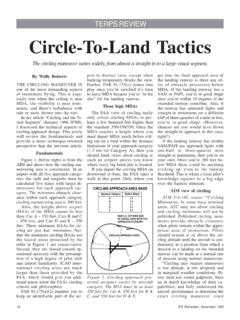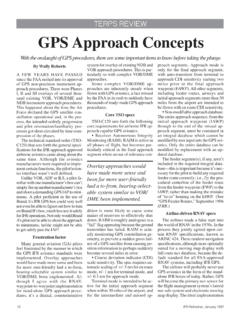Transcription of TERPS REVIEW The Approach Chart Rules!
1 TERPS REVIEWThe Approach Chart Rules! If you think sectional charts are a complex art, look at what goes into an Approach 1. Terrain and navaids require separate ILS and lo-calizer procedures at SNS. DME isn t required to use the WITH PERMISSION JEPPESEN SANDERSON, INC., 1996. ALL RIGHTS RESERVED10 IFR Refresher, June 1996By Wally RobertsONE OF THE MOST PERPLEXINGand complex procedural aspects of in-strument flying is the Approach charts are relatively straight-for-ward while others are complex and sub-ject to much discussion and debateamong instrument pilots, and instru-ment flight and ground (a) requires us to use anFAR 97 standard instrument approachprocedure (SIAP) when an instrumentletdown to a civil airport is necessary.
2 There is also an unless otherwise au-thorized by the Administrator escapeclause in (a). Interpretations andpolicy statements by the FAA over theyears have made it quite clear that aSIAP is necessary when arriving at anairport on an IFR flight plan with onlythree exceptions: (1) a contact Approach ,(2) a visual Approach , (3) or a specialinstrument Approach procedure specifi-cally issued to the , where do Jeppesen and NOS getthe SIAP from, and what really is theregulatory status of the Approach chartincluded with a standard Approach chartpackage? (For those of you who mightsay who cares? read on nonethelessfor hidden nuggets of wisdom.)
3 Procedure is an FARThis article will use two publicSIAPs for Salinas Municipal Airport(SNS), CA. The ILS RWY 31 (Figure1 on right) and LOC/DME RWY 31(Figure 2, page 11) are good examplesbecause the terrain and navaids at thislocale required the FAA to separate theprecision ILS procedure from the non-precision localizer procedure. This wasnecessary to take maximum advantageof TERPS criteria without causing un-due Chart clutter or imposition of a man-datory DME equipment requirement forthe precision ILS SIAP represents an individualamendment to FAR 97. The minimumaltitudes and segment lengths resultfrom application of TERPS vertical andlateral obstacle clearance airspace re-quirements to the Approach and missedapproach paths.
4 Sometimes, segmentaltitudes must be higher than requiredfor obstacle clearance in order to assurereception of a mandatory crossing ra-dial or, in unusual circumstances, theprimary navaid criteria further require thatdescent gradients specific to each of theinitial, intermediate, and final approachsegments not be exceeded in the designof the procedure. Also, alignment limi-tations and turning requirements be- TERPS REVIEW (continued on next page)IFR Refresher, June 199611tween segments and with respect to therunway or airport must be observed bythe FAA specialist during design of all these factors are workedthrough, and controlling obstacles arecarefully documented, then the trans-mittal form that will provide the infor-mation to Jeppesen, NOS and off-shorechartmakers (many foreign airlines useEuropean produced charts, even SIAPs) are completed in accor-dance with very specific directives.
5 ThisFAA transmittal form will hold its ownin any federal intramural complexitycontest with the IRS s aside, the FAA SIAP trans-mittal form must not only clearly indi-cate the segments, minimum altitudes,distances, minimums, missed Approach ,and procedural notes it must clearlyconform to agreed upon cartographicstandards so that essential elements ofthe graphical Approach Chart conformto Approach Chart cartographic the rule to the chartThe cartographic standards are theresult of the efforts of the government sInteragency Air Cartographic Commit-tee (IACC), which consists of the Com-merce and Defense Departments, inaddition to the FAA.
6 The cartographicstandards are set forth in an 80-plus-page document entitled, Low AltitudeInstrument Approach Procedures. NOS and the military services arestrictly bound to these standards, fromwhat must be in the plan and profileviews, to the size type used for speaking, Jeppesen isn tbound by these cartographic practical constraints, however, ef-fectively bind Jeppesen to the essenceof these standards: the form and con-tent of the SIAP regulatory transmittalform itself, and Jeppesen s need to holdits charts out as meeting FAA chartingrequirements. Even within these con-straints Jeppesen is provided consider-able wiggle room, which arguably re-sults in a better Chart format than thatprovided by the government s FAA transmittal forms forSIAPs are: 8260-3 for ILS (or MLS),8260-5 for all non-precision ap-proaches, other than ASR, and 8260-4for ASR and PAR approaches.
7 Figure3 (page 12) is the currently effective8260-3 for the SNS RWY 31 ILS andFigure 4 (page 15) is the 8260-5 for theLOC/DME the specific FAR 97 referenceat the top of each form. Each form rep-resents a specific amendment to FAR97; , ILS RWY 31, Amendment 5. The title, effective date, FAR 97 sub-part number, and amendment number(or original) are published in the Fed-eral Register (FR) in accordance withthe requirements of the AdministrativeProcedures Act. This gives every SIAPthe same force of law as, for instance,the IRS tax code. (You know what hap-pens if you don t pay your taxes.)ATC s minimal roleBy now, it should be pretty clear thatFigure 2.
8 DME is required to use this procedure and identifythe MAP, therefore, the timing table is WITH PERMISSION JEPPESEN SANDERSON, INC., 1996. ALL RIGHTS RESERVEDTERPS REVIEWThe Approach Chart (continued from page 11)12 IFR Refresher, June 1996an instrument Approach Chart (or, forthat matter, an IFR en route Chart ) bindsthe pilot a lot more than a lowly Sec-tional Chart . What might not be quiteas apparent, though, is that ATC doesn tpossess the training nor the authorityto amend any part of the Chart , exceptfor the authority given to it by theAdministrator to substitute an other-wise required initial Approach segmentwith a radar vector to the intermediatesegment ( : final approachcourse ) at an altitude compatible withthe SIAP.
9 It s all that use of radar byATC that gives the incorrect impressionthat controllers are experts in instrumentapproach ATC c lears you for an ap-proach, all it is saying, in effect: theairspace required to fly this approachand missed Approach is free of conflict-ing IFR traffic. Once you begin theapproach, you re in a deal with the Form8260-3 or -5, as represented on yourapproach Chart . ATC is out of picture,except to assure continued IFR trafficseparation and, at towered airports, pro-vide runway and local area course, ATC can wave you off inthe event of an unexpected traffic con-flict, but this means flying only the pub-lished missed Approach with a coupleof very limited exceptions: (1) there issometimes a second, alternative non-radar missed Approach set forth on the8260-3/5 where ATC has an occasionalneed for a second missed approachroute.
10 (This alternative missed approachisn t charted but is considered to be published in the legalese of the feds.)(2) Where radar exists, ATC can vectoryou for the missed. Where you are be-low the MVA (almost always the caseinside the FAF) the radar missed shouldonly occur near the airport or MAP, oroff to the side of the localizer in the veryspecial case of simultaneous ILS of the 8260 formNote that the SNS Forms 8260-3/5look a lot alike, except that the -5 formfor the LOC/DME jumps from Line 4to Line 8. The form is divided into 6major areas: plan view terminal routes,profile view distances and altitudes,minimums, notes, missed approachprocedure(s) and additional flight 5 through 7 appear only on theILS form, because they provide addi-Figure 3.


